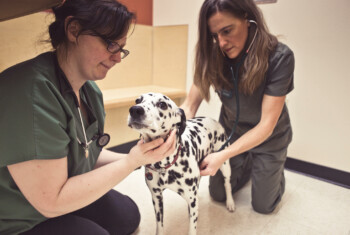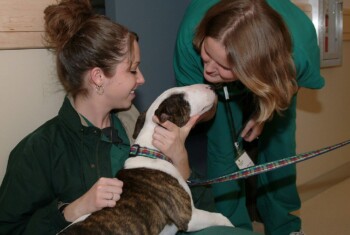Testicular tumors: Causes, signs and treatment.
Testicular tumors are considered one of the most common tumors in older intact male dogs. The overall incidence in dogs is not very high because most dogs are castrated (neutered) at a young age.
The three most common types of testicular tumors are Sertoli cell tumors, interstitial (Leydig) cell tumors and seminomas. About one-third of dogs that develop a tumor will have more than one of these types of tumors present. Other types of testicular tumors (i.e., embryonal carcinoma, lipoma, fibroma, hemangioma, chondroma, teratoma) can occur but are rare.
Causes.
The current cause of testicular tumor development is unknown. Although they are most common in intact older male dogs (>10 years), they can occur in intact males of any age and breed. Male dogs that have one or both testicles that have not descended from the belly cavity are much more likely to develop a tumor than dogs with normal (scrotal) testicles.
Tumors of normal descended, or scrotal, testicles are usually benign while those still located in the abdomen are much more likely to be malignant. Testicles retained in the abdomen are predisposed to the development of Sertoli cell tumors and seminomas. These tumors are slow to metastasize but may spread to lymph nodes.
Testicular tumors produce excessive hormones such as estrogen or testosterone. Sertoli cell tumors have a higher rate of spread than other testicular tumors. Dogs affected with these tumors show swelling of the testicular or scrotal area.
Interstitial (Leydig) cell tumors are benign and small. Dogs affected with these tumors show very few symptoms, and the tumors are usually incidental findings.
Seminomas arise from the cells of the testicle that normally produce sperm. The majority of seminomas are benign, and they rarely spread. Seminomas may lead to signs of female characteristics in a male dog. Most dogs are not ill, and many of these tumors are found during a routine physical examination.
Clinical signs.
Warning signs of testicular tumors include soft swellings in one or both testicles, a single enlarged testicle or asymmetric testicles, generalized scrotal enlargement, and infertility in the breeding stud. Hair and skin changes may include symmetrical hair loss, brittle hair, poor hair regrowth after shaving the coat, thin skin, hyperpigmentation (darkening of the skin) and a stripe of red inflammation along the midline of the prepuce.
Other signs include nipple elongation, mammary enlargement, penile atrophy, preputial swelling and sagging, testicular atrophy of the unaffected (noncancerous testicle), prostatic atrophy or enlargement, and anemia (pale gums). Behavioral changes may include squatting to urinate (versus hiking a limb), reduced sex drive and attraction of other male dogs.
Diagnosis.
Suspicion of a testicular tumor is based on the patient history and physical examination findings. In order to evaluate the patient suspected to have a testicular tumor, tests such as a complete blood count (CBC), biochemistry profile, urinalysis, chest and abdominal radiographs (x-rays), abdominal and scrotal ultrasound, fine needle aspiration of the testicular mass and histopathology (biopsy) of the removed testicle may be recommended.
Treatment.
Surgical castration is the primary treatment for testicular tumors. Complications following properly performed castrations are rare, but may include incisional problems such as swelling, infection, bleeding into the scrotum and self-mutilation of the incision.
In some cases, the testicular tumor is within the abdomen; therefore, an incision into the abdomen is needed to remove the tumor. Chemotherapy and radiation therapy can be pursued if the tumor has metastasized. Treatment of metastatic disease should be pursued.
Prognosis.
Surgery is curative for most testicular tumors. About 10-20% of the cases have spread at the time of diagnosis. Interstitial cell tumors and Sertoli cell tumors without spread or damage to the cells of the bone marrow have an excellent prognosis. Seminomas without signs of hyperestrogenism also have an excellent prognosis.
Damage to the cells of the bone marrow (caused by the excessive estrogen levels) can be fatal despite therapy but usually improves 2-3 weeks after tumor removal. The prognosis for testicular tumors that have spread is guarded but varies greatly depending on the location, type of tumor and treatment options.


